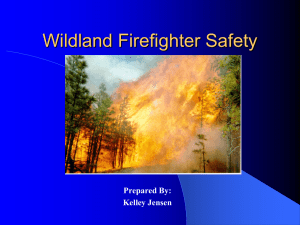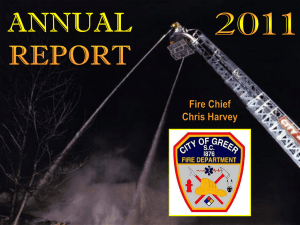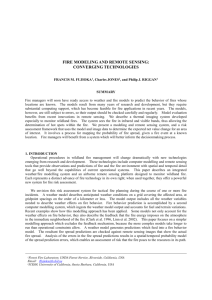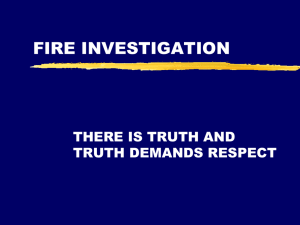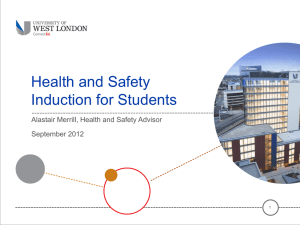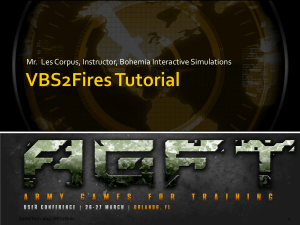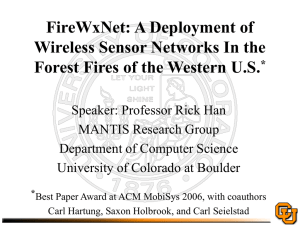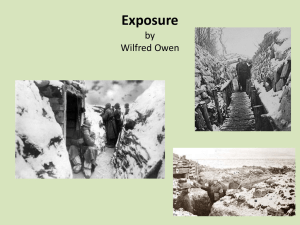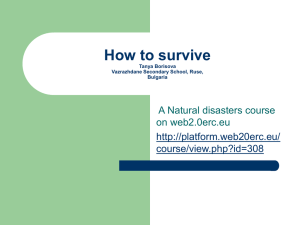52 - CMDR COE
advertisement
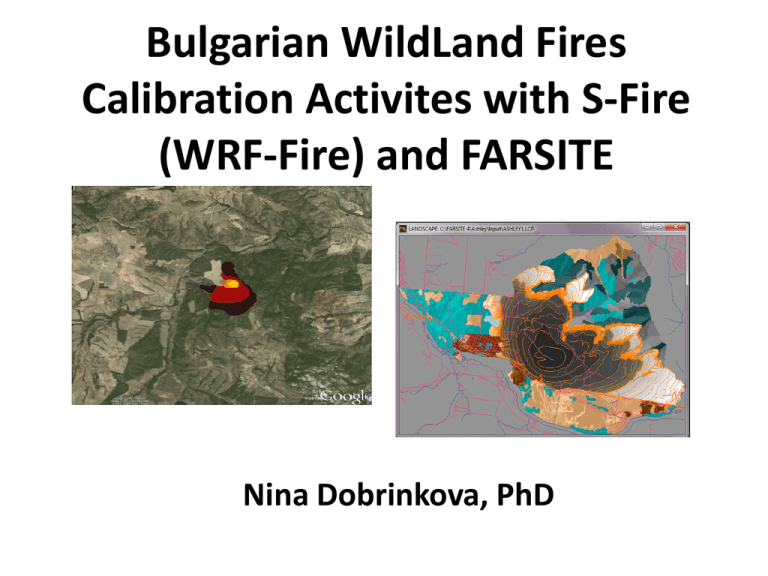
Bulgarian WildLand Fires
Calibration Activites with S-Fire
(WRF-Fire) and FARSITE
Nina Dobrinkova, PhD
In this presentation …
1) Introduction
2) S-Fire (WRF- fire) and Farsite models, some basics
3) Simulations done until now
4) Conclusions
Forest fire statistics - Europe
The number of fires since 1980 according to statistics done for the
southern member states has increased more than two times in some
years.
Forest fire statistics - Bulgaria
Bulgaria’s statistic about forest fires
1600
1400
Брой пожари
1200
1000
800
600
400
200
0
1970
1975
1980
1985
1990
1995
2000
2005
Година
1994 to 2006
1971 to 2006
• considerable increase of the number of fires after 1990 (more than 1000 in year 2000)
• more than 30 times increase of the burned area in the recent years
NASA Hot Spots statistics - Bulgaria
Fires in Bulgaria bigger than 1 km.
2006 to 2012
2006 to 2012
•More than 3500 fires in 2006 mostly surface fires
NASA Hot Spots statistics – Bulgaria Occurrence
WildLand Fires Nature
WildLand Fires Nature Surface Fires
• Surface Fires are close to the ground and they spread
either in peat (Picture 1) or in the grass- or bush- lands
(Picture 2)
Picture 1
Picture 2
WildLand Fires Nature Crown Fires
• Crown Fires usually occurs after active Surface Fire near
by leader fuels in Conifer type of forests (as shown on the
picture)
Propagation of Crown Fires
WildLand Fires Nature Spotting Fires
• Spotting Fires occur in conifer forests where we observe
torching trees. The embers may fly from 15-30 meters.
Propagation of Spotting Fires
WildLand Fires Nature –
Fire Acceleration
• Fire Acceleration is fire which occur on very steep slopes.
In this wildland fires the burning material and the steep
slope are moving the fire through the terrain very fast.
Fire Acceleration Spread
Simulation preparedness actions
Meteorological data
Original Rothermel Formula - FARSITE
I z
I xig
dx
z z
Heat Source
c
R
,
Heat Sink
q Q
0
be
ig
where:
R – is parameter for re spread or the so called ROS(quasi-steady Rate Of Spread),
• Ixig – is the horizontal spread of the heat absorbed by the burning materials
• evaporating their water content,
q be – is the density of the burning materials which are heated until the re start,
• Qig – is the absorbed energy by the burning materials while they are evaporating
• their water content,
I z – is the gradient of vertical intensity in the plane, where the energy is released.
z
FARSITE – weather input
weather.wtr
Month Day Precip Hour1 Hour2 Temp1 Temp2 Humid1 Humid2 Elevation rt1 rt2
L/m2 UTC UTC
tmin/0C max/0C max% min%
m
UTC UTC
12
9
56 2300 900
1
9
100
92
850 300 2300
•Precipitation is the daily rain amount specified in hundredths of an inch or millimeters (integer).
•Hour1 corresponds to the hour at which the minimum temperature was recorded (0-2400).
•Hour2 corresponds to the hour at which the maximum temperature was recorded (0-2400).
•Temperatures (Temp1 is minimum; Temp2 is maximum) are in degrees Fahrenheit or Celsius
(integer).
•Humidities (Humid1 is maximum; Humid2 is minimum) are in percent, 0 to 99 (integer).
•Elevation is in feet or meters above sea level. NOTE: these units (feet or meters)
do not have to be the same as the landscape elevation theme (integer).
•Precipitation Duration is optional with the beginning (rt1) and ending (rt2)
times (0-2400) of the daily rain amount. Only one time period per day is allowed.
If these fields are left blank the precipitation amount is assumed to be distributed
FARSITE – wind input
wind.wnd
Month Day Hour Speed Direction CloudCover
UTC km/h deg
%
12
9 300 23
167
100
•Hour is specified as 0-2359, to the nearest minute (integer).
•Speed is either the 20ft windspeed specified in miles per hour or the
10m windspeed in kilometers per hour (0-300, integer)
•Direction is specified in degrees, clockwise from north (0-360),
(integer). A "-1" in the direction field indicates the winds to be up
slope, similarly downslope winds can be specified with a "-2".
•CloudCover is specified as a percentage, 0 to 100 (integer).
FARSITE – DEM, Aspect, Slope, Canopy
Cover and Fuel Model inputs
File format ACII grid (ESRI format)
ncols
36
nrows
36
xllcorner 337098.21876909
yllcorner 4593900.8118804
cellsize 30
NODATA_value -9999
195 208 238 270 285 287 173 141 123 119 117 114 122 143 222 257 265 263 219 158 148 195 226 229 230 225 222 225 0 0 -9999 -9999 -9999 -9999 -9999
193 228 260 268 247 178 162 150 141 134 126 116 120 138 236 261 260 248 215 159 120 175 225 225 222 214 222 232 225 0 -9999 -9999 -9999 -9999 -9999
210 259 273 264 211 167 158 156 157 155 144 132 132 143 257 267 259 239 226 189 122 157 217 220 222 220 238 247 246 0 0 -9999 -9999 -9999 -9999
255 277 273 243 185 158 148 152 160 161 149 142 157 196 259 266 260 239 230 190 131 154 207 217 227 236 247 243 218 180 180 176 -9999 -9999 -9999
279 278 250 206 179 151 138 140 150 153 144 143 170 215 255 268 258 235 223 177 142 161 210 228 246 245 231 223 200 179 179 166 149 152 155 163
281 273 206 198 178 147 136 135 139 138 134 139 173 237 262 267 251 227 199 160 146 178 236 263 272 263 221 216 196 177 178 173 166 164 164 164
282 257 162 196 177 155 139 131 130 127 125 132 191 259 266 258 231 210 177 153 151 209 259 274 276 274 208 205 186 174 176 175 171 167 166 169
283 149 142 182 174 170 159 140 130 128 125 132 219 263 264 250 217 190 167 159 170 231 262 270 269 244 162 165 167 169 174 177 176 171 170 174
301 94 123 161 173 182 175 151 138 134 128 136 243 266 262 234 200 179 163 164 197 250 263 264 253 195 163 159 157 163 172 177 178 177 177 177
S-Fire (WRF-Fire) basics (1)
Mathematically the fire model is posed in the horizontal (x,y)
plane. The fire propagation is in semi-empirical approach and
it is assumed that the fire spreads in the direction normal to
the fireline. This is given from the the modified Rothermel’s
formula:
S=min{B0,R0 + ɸW + ɸS}, where
B0 is the spread rate against the wind;
R0 is the spread rate in the absence of wind;
ɸW is the wind correction
ɸS is the terrain correction
Simulation results with S-fire on Janus Cluster
at Denver Colorado University with Bulgarian
case fire near Harmanli.
We run S-Fire (WRF-Fire) model with real input data and we
set the inputs at:
Atmospheric model was run on 2 domains with 250m and
50m resolution
41 vertical levels were used
The fire module, coupled with the atmospheric domain is
run on 5m resolution with 0.3s time step
Simulated burned area and actual data from the Ministry of
Agriculture, Forest and Food showed good comparison
Simulation results on the Janus cluster at
UCDenver
Real burned area
Simulated burned area
Parallel performance
Cores
6
12
24
240
360
480
720
Real time
coefficients
10.59
9.21
3.91 2.75 1.64 0.99 0.61
0.44
0.37
0.31
36
60
120
Computations were performed on the Janus cluster at the
University of Colorado. The computer consists of nodes
with dual Intel X5660 processors (total 12 cores per node),
connected by QDR InfiniBand
The model runs as fast as real time on 120 cores and it is
twice faster on 360
(real time coef. = 0.99)
Simulation results with S-fire on Blue Gene/P
supercomputer with Bulgarian case fire near
Harmanli.
Cores
100 cores
128 cores
Time to finish the
run
7h 43 min.
failed
The simulated piece of the real fire is 2,5min long. The real-time coefficient is - 0,0054
much bellow 1.
IBM Blue Gene/P configuration is consisted of two racks with 2048 computational nodes
connected by PowerPC lines, 450 processors, 8192 cores and total 4 TB operational
memory. Every core can process two data streams (with double precision) after the
floating point. Sixteen input-output nodes are connected by optical connection 10 Gb/s
Ethernet
FARSITE – test case with real data from
US
We set the simulation for August 10th, 11th and 12th and the hours for the run are 12.00 h
noon time on August 11th until 18.00 h on August 12th.
The simulation run on 2 core laptop for 1 min. 6 sec. The simulated area is 46 km2
Follow up on the test area of Zlatograd forestry
department
Calibration of the Fires in the
Zlatograd Area
1.Elevation (terrain description)
2.Slope (terrain description)
3.Aspect (terrain description)
4.Weather
5. Canopy Cover - Fuel Type (Anderson 13 or
Scott-Burgan 40 classes. Acceptable are Custom
Types also.)
Vegetation Map of Zlatograd area
Bondev (1991)
Paper Map
Digitalized Paper Map
Comparison of Bondev (1991)
vegetation map and Forestry Map
Corine Map
Bondev Digital Map
Forestry Map
Comparison of Forestry and Corine
vegetation maps for Zlatograd Areas
Corine Map
Forestry Map
Forestry map fragment
Bondev map fragment
Corine map fragment
Calibration over real fires on Zlatograd
area
FARSITE RUN
Conclusions
Data availability is huge problem in Bulgaria
FARSITE is appropriate for operational estimations in real
time if there is correct input
S-Fire is giving opportunities for different weather scenarios,
but less flexibility in fire propagation, because of the surface
fire spread representation only.
Bulgaria needs Burning Materials Maps development for the
cases where fire behavior modeling is applied
Acknowledgements
International project under the Greece-Bulgria
territorial
cooperation
program
2007-2013,
accepted under priority axis: Quality of Life and area
of intervention: Protection, Management &
Promotion of the Environmental reseources. Project
name:”Open Protocols and tools for the education
and Training of voluntary organisations in the field of
Civil Protection, against natural Dissasters (forest
fires) in Greece and Bulgaria”, acronym: “OUTLAND”
Thank you for your attention!
Nina Dobrinkova, PhD
nido@math.bas.bg


